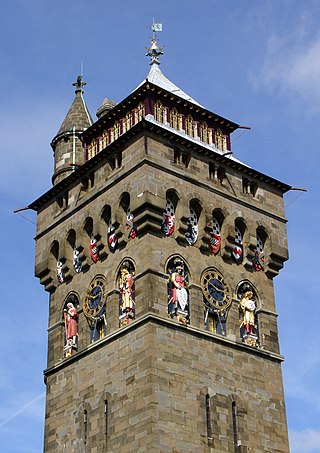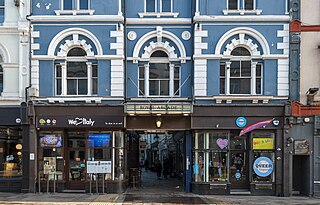
Cardiff is the capital and largest city of Wales. Cardiff had a population of 362,310 in 2021 and forms a principal area officially known as the City and County of Cardiff. The city is the eleventh largest in the United Kingdom. Located in the southeast of Wales and in the Cardiff Capital Region, Cardiff is the county town of the historic county of Glamorgan and in 1974–1996 of South Glamorgan. It belongs to the Eurocities network of the largest European cities. A small town until the early 19th century, its prominence as a port for coal when mining began in the region helped its expansion. In 1905, it was ranked as a city and in 1955 proclaimed capital of Wales. Cardiff Built-up Area covers a larger area outside the county boundary, including the towns of Dinas Powys and Penarth.

Spillers Records, established in 1894, is recognised as the oldest record shop in the world, despite having gone through various stages of ownership and locations. It is located in Cardiff, Wales. In addition to selling music, it is the city's main location for buying tickets for alternative music concerts.

Cardiff city centre is the city centre and central business district of Cardiff, Wales. The area is tightly bound by the River Taff to the west, the Civic Centre to the north and railway lines and two railway stations – Central and Queen Street – to the south and east respectively. Cardiff became a city in 1905.
Swansea city centre in Swansea, Wales, contains the main shopping, leisure and nightlife district in Swansea. The city centre covers much of the Castle ward including the area around Oxford Street, Castle Square, and the Quadrant Shopping Centre; Alexandra Road, High Street, Wind Street and the Castle; Parc Tawe; and the Maritime Quarter extending down to the seafront.

St David's, previously known as St David's Shopping Centre, is one of the principal shopping centres in the city centre of Cardiff, Wales. It is in The Hayes area of the southern city centre. Following the extension of St David's 2 in 2009, St David's is the third busiest shopping centre in the United Kingdom.

Howells was a large department store located on St Mary Street in Cardiff, Wales, established by James Howell in 1865. It was acquired by the House of Fraser group in 1972 and re-branded as House of Fraser in 2010.
Solomon Andrews was a British entrepreneur and head of the Solomon Andrews and Son bus and tram-operating company, based in Cardiff.

David Morgan was an independent department store in Cardiff that ceased operating in January 2005 after 125 years of trading. It opened on 31 October 1879 and closed its doors for the final time on Saturday 30 January 2005.

The Cardiff Centenary Walk is a tourist walkway through Cardiff city centre in Wales. Established as part of Cardiff's centennial celebrations to mark 100 years of city status in 2005, it has 41 points of interest, either Cardiff landmarks or significant historic sites. The route is marked by waymarkers on the pavement, which also direct pedestrians to the next waymarker. The whole walk is 3.6 kilometres (2.2 mi) long running around Cardiff in a clockwise direction, starting and finishing at the Cardiff Visitor Centre at the Old Library.

The Hayes is a commercial area in the southern city centre of the Welsh capital, Cardiff. Centred on the road of that name leading south towards the east end of the city centre, the area is mostly pedestrianised and is the location of the Hayes Island Snack Bar.
As the capital city of Wales, Cardiff is the main engine of growth in the Welsh economy; the city has been developing as a significant service centre and economic driver for the wider south east Wales economy. The city and the adjoining Vale of Glamorgan contribute a disproportionately high share of economic output in Wales. The Cardiff travel to work area has grown significantly since 1991; the 2001-based version includes much of the central South Wales Valleys in addition to the Vale of Glamorgan.

Cardiff has many cultural sites varying from the historical Cardiff Castle and out of town Castell Coch to the more modern Wales Millennium Centre and Cardiff Bay. Cardiff was a finalist in the European Capital of Culture 2008.

St Mary Street and High Street are major commercial streets in the Castle Quarter of Cardiff city centre, Wales, which form a major thoroughfare running south from the gatehouse of Cardiff Castle. High Street begins at the junction of Castle Street on the A4161 and ends at the junction of Church Street and Quay Street, from where St Mary Street begins until the roundabout at Callaghan Square on the A4160.

Architecture in Cardiff, the capital city of Wales, dates from Norman times to the present day. Its urban fabric is largely Victorian and later, reflecting Cardiff's rise to prosperity as a major coal port in the 19th century. No single building style is associated with Cardiff, but the city centre retains several 19th and early 20th century shopping arcades.

Castle Quarter is an independent retail destination area in the north of the city centre of Cardiff, Wales. Castle is also a community (parish) of Cardiff.

The Royal Arcade is a shopping arcade in Cardiff, South Wales.

Caroline Street is a pedestrianised street running east–west in the lower part of Cardiff city centre, located between The Hayes and St. Mary's Street. Due to the density of fast food shops along the street, it is colloquially referred to as Chip Alley, or Chippy Lane.

The Prince of Wales Theatre is a former theatre in central Cardiff. Built in 1878, seating 2,800, it later became a sex cinema. It is now a pub.
















